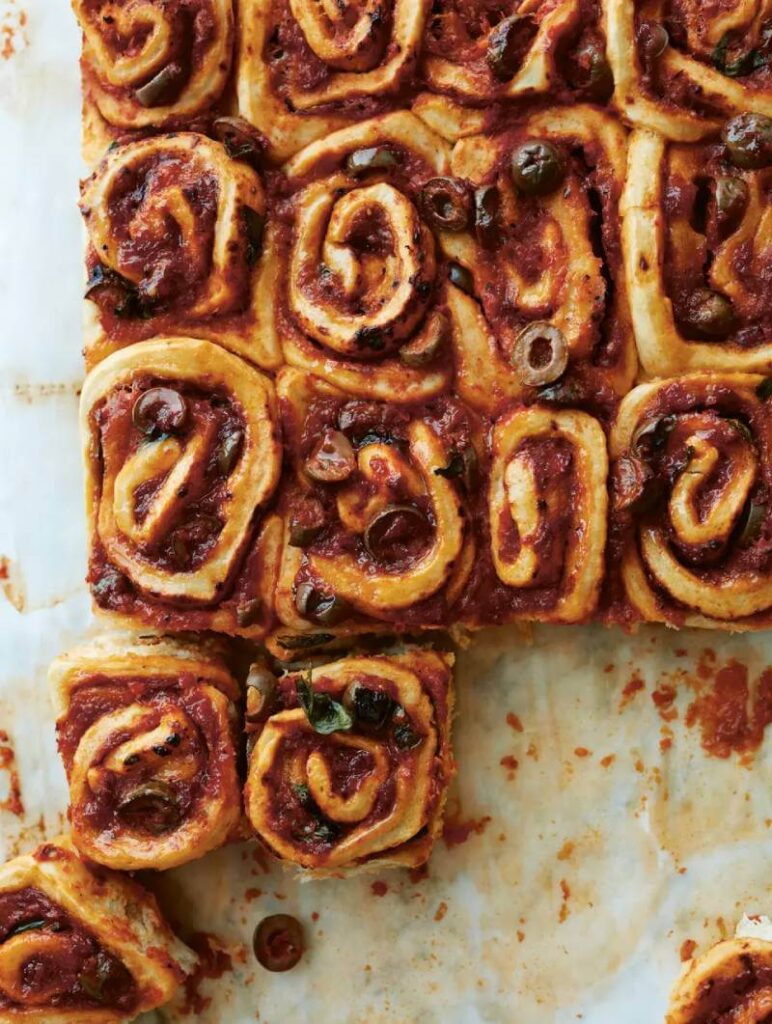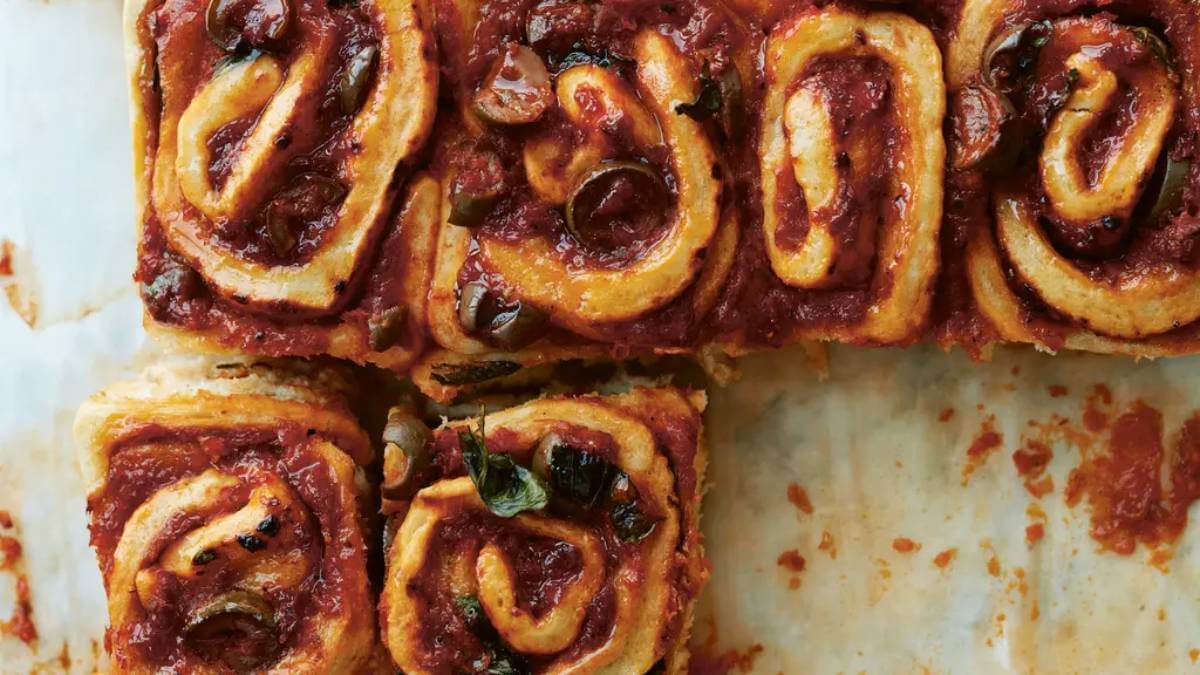“This tear-and-share traybake makes a great and always welcome addition to an informal dinner buffet, a picnic or a kids’ birthday party,” says Giuseppe Dell’Anno, winner of The Great British Bake Off 2021.
“Common fillings include the usual tomato sauce, mozzarella and often ham; however, this recipe uses one of my favourite combinations based on ripe red sweet capsicums and onions.”
Serves: 20
Ingredients:
For the dough:
- 450g strong bread flour
- 3 teaspoons dry yeast
- 2 teaspoons caster or granulated sugar
- 250g lukewarm water
- 3 tablespoons extra virgin olive oil
- 2 teaspoons salt
For the filling:
- 350g red capsicums (about three medium capsicums)
- 100g red onion (about 1 small onion)
- 2 tablespoons extra virgin olive oil, plus extra for greasing
- 1/8 teaspoon salt
- 2 tablespoons concentrated tomato puree
- 100g green olives, pitted and sliced
- ground black pepper, for seasoning
- 50g grated Parmesan
- a few fresh basil leaves, roughly chopped

Method
Add the flour, yeast and sugar to the bowl of a stand mixer fitted with the dough hook and mix them with a spoon until fully combined. Start the mixer on a medium-high speed and slowly trickle the water into the mixing bowl. Immediately after the water, add the oil and continue mixing until the dough comes together evenly. It should take a couple of minutes. Sprinkle in the salt and let the mixer knead the dough for a further eight to 10 minutes, or until it becomes smooth, wraps around the hook and comes off the sides of the mixing bowl cleanly.
Scoop the dough out of the bowl and, while holding it in your hands, stretch it and fold it over itself a few times and shape it into a ball. Drop it back into the mixing bowl, cut a deep cross on the surface with a sharp knife, cover the bowl with clingfilm and leave the dough to prove until it has doubled in volume; it should take about one hour 10 minutes at 20°C. A very practical solution to prove the dough is to leave the bowl in the closed oven, with the heating off but the internal light switched on. This will generate an optimal draught-free and slightly warm environment to facilitate the action of the yeast. Proving the dough in these conditions may shorten the proving time.
Meanwhile, prepare the filling: wash the capsicums, remove the stems, cores, white pith and seeds, and roughly chop the skin into two to three centimetre pieces. There is no need to be accurate as they will be blended once cooked. Peel and chop the onion, then place it in a medium frying pan with the oil and the chopped capsicums. Add the salt and shallow-fry over a medium heat, uncovered, for about five minutes, stirring often until the onion has become translucent. Add the tomato puree and about 125 grams water, cover the pan with a lid, reduce the heat and simmer for about 15 minutes until most of the liquid has evaporated. Keep checking that the pan does not dry out to avoid burning the sauce.
Remove the pan from the heat and cream the contents in a heatproof blender or with a stick blender. Set aside to cool.
Grease the baking tin, spreading a thin layer of olive oil over the bottom and sides. Line the bottom with a sheet of baking paper.
Drop the proved dough over a well-floured surface, roughly shape it into a square with your fingers, then roll it out to a thickness of five millimetres, shaping it into a 30 x 50 centimetre rectangle. With the longest side facing you, pour the capsicum filling over the dough, and spread it with the back of a spoon or a small offset spatula, leaving two to three centimetres of dough at the top of the rectangle sauce-free. Distribute the sliced olives evenly over the dough. Grind a generous dusting of black pepper over the sauce, sprinkle over the grated Parmesan and add the basil leaves. Roll the sheet of dough, starting from the side facing you, all the way to the top.
Using a sharp knife, slice the sausage of filled dough into 20 equal rolls, about two-and-a-half centimetres thick, and arrange them sideways in the prepared baking tray. There might be space left between the rolls at this stage; however, this will be filled by the dough during the second prove and baking. Leave the rolls to prove again, uncovered, for a further 30 minutes.
Meanwhile, set the shelf in the lowest position in the oven and preheat it to 200°C (400°F/ Gas mark 6). Once the second prove is completed, bake the rolls for 27–29 minutes, or until the tops just start to brown. Store, wrapped in paper, for up to a day.

Giuseppe’s Italian Bakes by Giuseppe Dell’Anno is published by Quadrille. Photography by Matt Russell. Available now.
What do you think of these Italian pizza rolls? Why not share how the recipe turns out for you in the comments section below?
Also read: Simple Tray Pizza with Custom Toppings
– With PA

